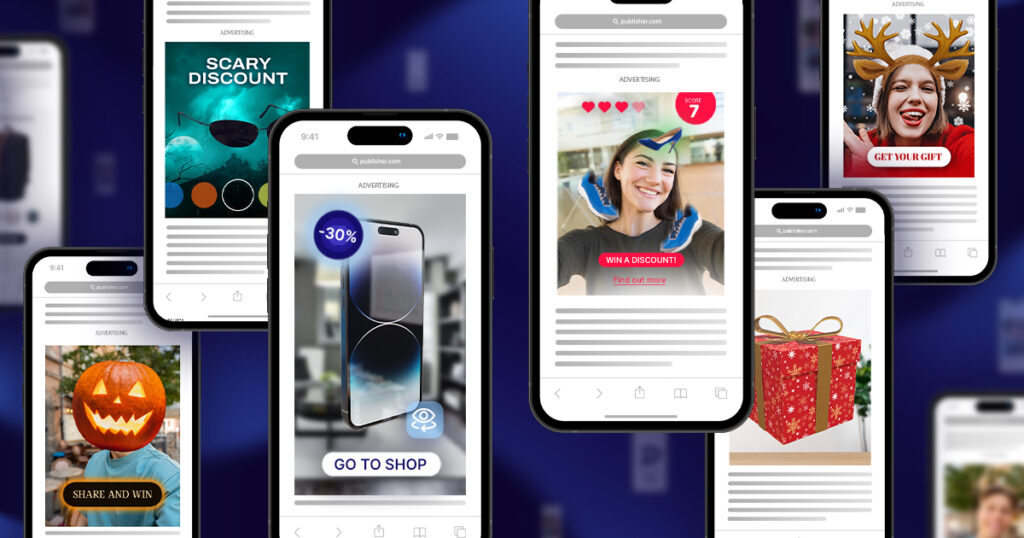Why Augmented Reality is the Now, as Virtual Reality Waits for Its Moment

By Claudia Mastromauro, Vice President of Sales, Strategy & Operations in the UK for Aryel
The steep cost of Apple Vision Pro might lead marketers to quickly discount it as a viable platform for advertising. Nevertheless, the potential of extended reality (XR) to connect with consumers in unparalleled ways should not be overlooked. In this article, I want to emphasise the importance of utilising such technology not merely for its novelty. For brands, the strategic use of technologies like XR is essential to forming a meaningful link between the message they wish to convey and the everyday lives of consumers.
The consumer demand for engaging, immersive experiences that align with their interests and enhance their interactions is clear. Brands that heed this call stand to gain significantly. A notable 57% of consumers express a greater likelihood to purchase from brands that provide immersive experiences, with 64% stating that such experiences boost their loyalty towards a brand, especially if integrated into the shopping experience.
The push towards immersive experiences by brands has spurred significant growth in Extended Reality (XR), a collective term for technologies such as Augmented Reality (AR), Virtual Reality (VR), and Mixed Reality (MR). The global market for XR is expected to surpass the trillion-dollar mark by 2030. This surge has not only attracted the attention of leading tech firms but also accelerated the development of XR technologies, with the Apple Vision Pro being among the latest standalone XR headsets.
For brands aiming to lead their industries, Apple's venture into the XR headset market provides unique opportunities for innovation. XR headsets are set to transform immersive experiences and set new standards for user engagement. However, these opportunities come with potential challenges. The considerable cost, alongside practical issues like the headset's weight, convenience, and accessibility, poses considerations for consumers. For brands, understanding how to engage a still-limited audience due to these factors is crucial.
Yet, these challenges do not extend to web-based AR technologies, which enable AR functionalities directly through web browsers and mobile devices, bypassing the need for extra equipment.
So, how can brands effectively traverse the evolving XR landscape, selecting the right technologies to deliver impactful, innovative customer experiences that enhance marketing outcomes and achieve business goals?
THE IMPLICATIONS OF XR HEADSETS FOR BRANDS
The ability of brands to connect with consumers via XR headsets holds great potential, especially with a content-first approach.
Creating branded experiences through XR headsets that are not only engaging but also provide real value to consumers is a strategic necessity rather than a mere tactical choice. This approach must start with an in-depth understanding of the target audience's needs, preferences, and interests, particularly those likely to use XR headsets.
Moreover, venturing into XR advertising allows for the exploration of new or complementary strategies, giving marketers the chance to enrich their existing media mix. For brands looking to establish themselves as innovation leaders and deepen customer engagement, experimenting with XR offers a chance to explore novel storytelling and interactive forms, thereby enhancing user engagement and brand loyalty, and fostering more profound consumer-brand connections.
However, investing in an additional, expensive device like the Apple Vision Pro — desired by 40% of consumers at a lower cost — that is also cumbersome to wear and use only under specific conditions, might limit brands' ability to connect with their audience exclusively through XR headsets. This approach could also lead to substantial initial costs for developing, testing, and maintaining XR-specific content.
THE PRACTICALITY OF WEB-BASED AR TODAY
For brands seeking to expand their reach beyond the potential niche of XR headset users, while still leveraging the immersive capabilities of recent technological advances, web-based AR advertising presents a more viable, scalable, and immediate option.
Web-based AR allows consumers to experience digital content superimposed onto their real-world environment without needing special apps, simply using their camera phones. This content can be quickly developed and integrated into existing websites and marketing campaigns by advertisers. It also facilitates the collection of first-party data, which can inform more tailored and effective future campaigns.
Advertising campaigns that incorporate web-based AR are gaining momentum, noted for their ability to capture attention fourfold and increase brand recall by 1.3 times compared to standard online advertisements, significantly boosting conversion rates by up to 94%. Furthermore, they offer an added immersive dimension to existing marketing initiatives.
With more than 60% of the advertising sector keen on exploring AR within the next couple of years, the pivot towards web-based AR advertising is a strategic endeavour by brands to meet consumers within their digital environments. These experiences are not only engaging and contextually relevant but also readily accessible, marking a pivotal moment in marketing as the boundaries between the digital and physical worlds merge, opening up new avenues for brand-consumer engagement.
Although XR headsets like the Apple Vision Pro are moving the advertising world towards immersive formats, web-based AR emerges as a more accessible, immediate, and broad-reaching format to effectively engage a wider audience. It allows consumers to blend the digital with the digital seamlessly into their everyday lives, offering brands a powerful tool to enhance consumer interactions and deepen brand loyalty. This integration of web-based AR into marketing strategies reflects a broader trend within the UK market, where immersive technologies are not merely futuristic concepts but are shaping the present landscape of consumer engagement.
The rising demand for engaging, immersive experiences is a clear signal for brands to leverage AR to meet consumer expectations. With AR's capability to provide media-agnostic solutions—enabling direct in-banner ads without the need for app downloads—it opens up a myriad of possibilities for brands to reach audiences across various platforms. This approach not only captures but also retains consumer attention through immersive experiences that significantly enhance brand recall and buy intent.
As the UK continues to emerge as a leader in the adoption of immersive technologies, the significance of AR and VR in transforming marketing strategies cannot be overstated. The Interactive Advertising Bureau UK's insights into the transformative potential of immersive advertising underscore the opportunities for brands to forge deeper connections with consumers. Moreover, PwC UK's projections highlight the substantial economic contributions of AR and VR, emphasising their importance beyond mere technological novelties to pivotal elements in the future of advertising and consumer interaction.
The strategic necessity for brands to create content-first experiences through XR technologies is more evident than ever. With the global XR market on the brink of surpassing the trillion-dollar mark by 2030, brands have a unique opportunity to pioneer in creating novel storytelling and interactive forms. This not only fosters enhanced user engagement and brand loyalty but also positions brands as leaders in innovation.
However, the high costs and practical considerations associated with devices like the Apple Vision Pro necessitate a balanced approach. Brands must navigate the evolving landscape of XR by integrating both the cutting-edge capabilities of XR headsets and the broad accessibility of web-based AR. This dual approach enables brands to not only captivate a niche audience with high-end XR experiences but also engage a wider audience through easily accessible web-based AR applications.
As we stand at the juncture of digital innovation, it is clear that the integration of AR and VR into marketing strategies is not a question of if but when. The current market dynamics, characterised by a keen interest in AR among the advertising sector and the growing consumer demand for immersive experiences, call for brands to act swiftly.
By embracing these technologies, brands can create engaging, memorable, and impactful consumer experiences, setting a new benchmark for consumer engagement in the digital age.
In conclusion, the journey into immersive digital futures is already underway, with AR serving as the gateway for brands to connect with consumers in more meaningful ways. As VR continues to develop and find its moment, AR stands out as the immediate path for brands to make a significant impact.
The blend of innovation and accessibility offered by AR and VR technologies marks a pivotal moment in marketing, promising a future where the boundaries between the digital and physical worlds are not just blurred but seamlessly integrated. For brands ready to navigate this landscape, the opportunity to redefine consumer engagement and establish a lasting connection with the market is now.
ABOUT THE AUTHOR
Claudia Mastromauro, with a robust 16-year background in ad-tech at leading firms including Yahoo and eBay, now spearheads Aryel's Sales Strategy in the UK as VP. She is at the forefront of delivering scalable augmented reality advertising solutions tailored for brands, media agencies, and publishers. Committed to empowering women in tech, Claudia is not only reshaping the future of advertising but also advocating for greater inclusivity and diversity within the industry.


